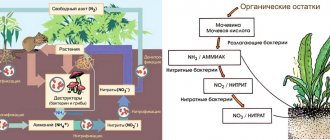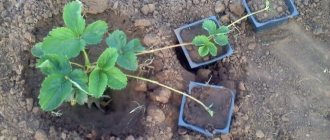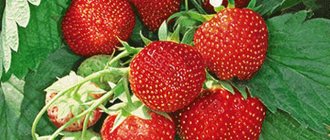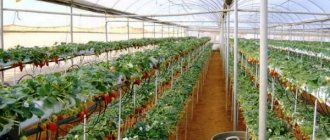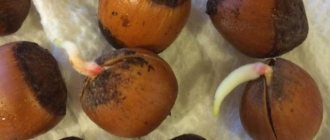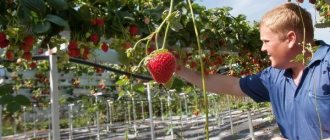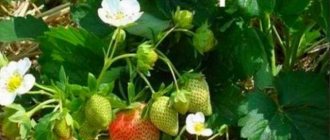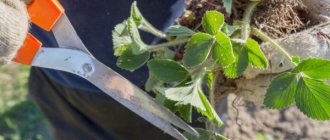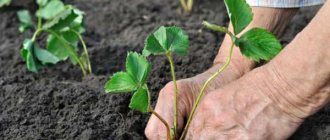What is the best time to plant?
Previously, properly rooted strawberry seedlings were only available in early spring or fall; now they can be planted throughout the growing season. Thanks to the emergence and development of new nursery technologies, in addition to traditional seedlings (green), frigo seedlings (available from early spring to early summer), and potted seedlings (available throughout the growing season - from early spring to late autumn) are now sold. . In the south, strawberries are often planted in the fall, in the middle zone, and in the Moscow region - in the spring or at the end of summer under film.
Summer
Practice shows that planting strawberries in open ground in summer (in July and August) brings the greatest benefits.
The main benefits of planting strawberries in August are as follows:
- This applies only to traditional (non-remontant) varieties. Strawberries planted during this period have enough time before winter to create a strong root system and a large number of flower buds.
It should be mentioned here that the amount of harvest is determined by the number of buds that are formed in the so-called short day, that is, in the fall.
- Summer planting of strawberry seedlings allows you to harvest the most complete harvest of strawberries next year, that is, to achieve the maximum yield for a given variety under certain conditions.
- The summer planting period minimizes the so-called investment period, that is, the time during which we must incur costs associated with caring for planted plants (watering, fertilizing, protection from diseases, pests).
Unfortunately, the highest availability of seedlings occurs in September-October, although the best conditions for planting are in the summer, from late July to mid-August - then the plants grow well and develop properly before the onset of winter.
Spring
Spring planting of garden strawberries also has advantages and is certainly better than late autumn (eg November).
The advantages are as follows:
- In spring there is usually no shortage of well-rooted strawberry seedlings of all types, and there is a wide selection of varieties.
- The soil is sufficiently moist (seedlings are easily accepted).
There is only one “but”: strawberries planted in the spring in the first year, as a rule, give a symbolic harvest, usually a few berries from the plant (this does not apply to very expensive seedlings of frigo class A + or higher, the so-called multi-rooted ones).
Don't expect your first "real" harvest until next spring. Therefore, for several months you will have to bear the costs associated with caring for the plants (weeding, irrigation, fertilizer, possible protection from diseases and pests).
Autumn
The timing of planting strawberry seedlings in the fall depends on different conditions. In practice, the most frequently chosen date for autumn planting of strawberry bushes is September. If the plantation is irrigated properly, plants planted in the fall in the first half of September will take root and grow well until winter.
Seedlings planted in late September or October will not have enough time before winter to develop a strong root system and set many flower buds. Therefore, next year's harvest will be moderate (although the yield from September plantings is usually higher than from October plantings). When planting in the fall, the time from planting to full harvest is further extended by about six months (including another winter).
Planting in late autumn is often fraught with risk - there is a danger that the seedlings will not have time to take root properly before the first frost, and this can have a significant impact on reducing their winter hardiness.
However, seedlings in pots with a formed closed root system take root more easily (they do not experience the stress of replanting).
In practice, planting dates depend on many factors - soil structure, availability of irrigation, site preparation, availability of seedlings on the market and our financial and technical capabilities.
Climatic and soil requirements
The climate of the middle zone, not to mention the southern regions, is usually well suited for strawberries, especially for zoned varieties. Growing new varieties, especially from other climatic zones, is associated with the risk of losses from frost. Especially in harsh and snowless winters. Fortunately, thanks to readily available agrotextiles, this type of loss can be significantly minimized.
For strawberries you need to find a place that is sunny and protected from strong and frosty winds. It is necessary to avoid especially lowlands where frosts descend.
Strawberries are not particularly demanding on soil. It grows well and bears fruit in most soils, provided they:
- not too heavy;
- well drained;
- well-groomed (correct structure, no malicious weeds).
Must be avoided:
- dry sandy soils;
- very moisture-intensive soils, not airy or waterlogged; You should not plant strawberries in wetlands where the root system will not breathe normally.
The soil reaction should be slightly acidic or neutral (pH 5.5-6.5).
Watering strawberries
Strawberries, like many plants, love water. And even if the beds are covered with mulch, you need to maintain soil moisture, it is necessary for the growth and development of strawberries. You can determine whether strawberries need watering as follows. If the soil sticks to your hands, there is no need to water, but if the soil crumbles, water immediately. Too wet soil harms strawberries. Therefore, it should be watered twice a week. When the strawberries begin to ripen, watering should be increased to once every five days.
How to properly prepare the soil?
It is important to know how to prepare the ground for planting strawberry seedlings.
Weed removal
The first step in preparing a bed for planting is to effectively remove noxious perennial weeds (wheatgrass, thistle, horsetail). If this is done carelessly, it can cause huge weed problems in the years to come. Strawberries will compete with weeds for water, nutrients, and light. This will affect the height and quality of the harvest, not to mention the difficulty of harvesting.
Perennial weeds can be removed several weeks before planting strawberries using the readily available herbicide Roundup or any of its substitutes. You need to spray for at least 1 hour before rain (this is the approximate absorption time of the active substance) in an amount of 30-50 ml per 100 m², but it is better to carry out the treatment in dry weather. The method of preparing the solution is indicated on the drug label. The active substance in Roundup (glyphosate) is absorbed by plant tissues and transported by sap to the roots and shoots. By interfering with metabolic processes in cells, glyphosate leads to the death of weeds within 10-14 days.
Attention! Glyphosate-based herbicides are toxic; it is important to follow the safety precautions indicated on the product packaging.
Fertilizer application
The next step - if we did not do this before planting the predecessor - is to apply organic fertilizers for strawberries when planting in the fall, for example:
- manure (necessarily old, composted);
- or regular compost in an amount of 400-600 kg/100 m².
After applying organic fertilizer, it is important to thoroughly dig the area.
The nutrients contained in organic fertilizers undergo slow mineralization in the soil, making them available to plants over a long period of time (2-3 years).
If there is no manure or not enough, you need to provide the soil with additional (or replacement) multicomponent mineral fertilizers, which must not contain chlorine (preferably special ones for strawberries), in an amount of 5-8 kg/100 m². On poor soils the dose can be increased.
After digging, the area is leveled with a rake and after a few days (let the soil settle a little) you can plant strawberries.
Sometimes, for example when the soil pH is <5.5, it may be necessary to add calcium. This can be done by distributing chalk (preferably granular) in an amount of 15-20 kg per square meter.
Attention! It is impossible to combine the application of calcium with the application of manure, since calcium enters into undesirable chemical reactions with nitrogenous compounds present in organic fertilizers, which leads to the release of ammonia and, thus, to the loss of a valuable component - nitrogen.
Pest Control
Sometimes before planting strawberries you have to fight pest larvae in the soil. They are easy to find at the digging stage. If there are a lot of larvae, you should refrain from planting for several weeks and use one of two solutions:
- Water the soil with a solution of one of the special preparations, for example, Dursban, Nurelle, Mospilan. Detailed instructions for use can be found on the package label.
- Apply biological drugs.
Planting strawberry bushes in soil infested with pests does not bode well. Strawberry roots are very tasty for the larvae, and the effect of their feeding is very unpleasant (often whole plants wither and fall out).
Interesting fact! Growing buckwheat as a precursor eliminates pest larvae from the soil that feed on the root system of strawberries. Marigolds, as a precursor to strawberries, are effective in controlling harmful soil nematodes.
Caring for strawberries after germination from seeds
The “sowing season” is over, and now we have to provide the emerging seedlings with comfortable conditions and proper care.
Temperature
Garden strawberry seedlings require heat. It is necessary in the initial period (1-1.5 weeks after emergence) to maintain a temperature of +21ºC...+23ºC, then +18ºC is sufficient. High rates lead to stretching and weakening of plants.
At first, the lid or film is not removed from the boxes or containers, but as soon as the plants have two true leaves, the protection is removed. LED lamps and phytolights are used for lighting. Daylight hours should be at least 12-14 hours. If it is not possible to provide additional illumination in February-March, then the seeds are sown later.
Irrigation
Strawberry seedlings do not tolerate drought and die from waterlogging. The gardener’s task is to ensure an optimal irrigation regime, keeping the substrate slightly moist and not allowing it to dry out.
Water in the morning, under the roots, avoiding moisture getting on the tender leaves of the seedlings. The water is settled and heated, and the watering itself is done through a syringe or pipette. Watering with melt water gives good results, but it is better not to use tap water.
Feeding
Over a long period of growing seedlings, several feedings are carried out. The culture quickly depletes the substrate, taking nutrients from it, so when the seedlings growing in pots or tablets have 2-3 true leaves, they are fed.
Seedlings in common boxes begin to be fed after picking (4-5 days), monitoring the condition of the plants. The further schedule is once every 10-12 days.
It is recommended to use complex mineral fertilizers (nitrophoska), diluting fertilizers according to the instructions, as well as solutions of ready-made compounds. For strawberries, commercial products such as Rastvorin, Fertika, and Aquarin are suitable.
Picking
When sowing in common containers or boxes, the seedlings dive. The approximate time for picking is the appearance of two true leaves. It is convenient to dive with the help of available devices: flat ice cream sticks, plastic tubes for juice. This makes it easier to pry the plant and not damage the roots.
Seedlings with a lump of soil are removed, carefully transferred to a separate container, and placed in the prepared hole. Then lightly sprinkle with soil and irrigate. Place the picked plants in a shaded place for 2-3 days, then maintain normal temperature conditions.
Preparing for landing at a permanent place
In order for the seedlings to quickly take root in a new place, the seedlings begin to harden off in about 10-12 days, taking them to the veranda, loggia or greenhouses. The first days - for 15-20 minutes, gradually increasing the duration to several hours.
This procedure hardens the plants, they tolerate adaptation more easily and do not get sick. Before planting, the substrate is watered abundantly. To prevent and protect against pest attacks, it is recommended to spray the seedlings with a solution of any insecticidal preparation.
Purchase and transportation of seedlings
You need to buy only certified materials from the nursery, free from diseases and pests. Well-grown seedlings should have several properly developed leaves, a healthy bud and adequate length of light brown, intact roots. Plants purchased in the spring may not have developed leaves yet. After purchasing seedlings, it is important to transport them correctly.
How to preserve strawberry tendrils before planting?
- They should not be overdried during transportation.
- It is necessary to protect the roots from the sun and wind; it is recommended to place the root system in plastic bags.
- Planting should be done immediately after purchasing and transporting the plants.
- If this is not possible, the seedlings can be stored for several days in a cool room at a temperature of about 5 °C and high humidity.
Preparing a plot for strawberries
Clear the soil of weeds, then add three buckets of humus per square meter. Soak strawberry bushes in a solution of copper sulfate (30 grams per 10 liters of water), this will protect against fungus and disinfect.
Complex fertilizer: 1.5 - 2 tbsp. double superphosphate, 1 tbsp. potassium chloride and a bucket of humus for 1 sq. meter of area.
Planting strawberries
Sockets dug out of the ground should lie for 12 hours in a cool basement or cellar.
Strawberries need to be planted in shallow holes, which must first be filled with water. You can also add ash or humus to the holes. After the strawberry bushes are planted, cover them with soil so that the core is at ground level.
Firm the soil around the strawberries and water.
The best predecessors
Strawberries have their best and worst predecessors - after one plant it grows and bears fruit better, after others it grows worse or even worse.
Predecessors of strawberries
| Good | Bad – it is not recommended to plant strawberries after: |
|
|
Planting in beds
Proper planting of garden strawberries along with high-quality seedlings and soil preparation is the key to successful strawberry growing.
Work progress
Having prepared the seedlings and the site, they begin planting. Work is carried out in cloudy weather and at fairly low air temperatures. If this is not possible, it is warm and cloudless outside, you should water the plants immediately after planting and mulch with straw for a week. This contributes to better seedling acceptance. If the seedlings have dried out during transportation, they should be soaked in water 1 hour before planting. Correct planting technique guarantees good seedling reception.
- It is convenient to plant strawberry tendrils along the stretched threads that outline the rows.
- First, holes are dug deep enough to accommodate the entire root system. The roots should not be curled, and if necessary they are shortened with sharp scissors.
- Before planting, remove old leaves; a few young leaves and an intact growth point should remain on the seedling.
- The seedling is placed vertically in the hole so that the roots are completely covered. You can read more about planting depth below.
- The roots spread out in the hole are carefully covered with soil, then the soil is well compacted.
- The next stage is mulching the planted plants.
- If necessary, remember to water the seedlings so that the plants are not exposed to drought.
At what distance and depth should I plant?
The distance between strawberry bushes must be chosen correctly. In small areas, I would like to plant strawberries as densely as possible in the hope of a high yield. On the other hand, there is a reasonable limit on the number of plants per unit area.
A small distance between rows and strawberry bushes has a number of negative consequences:
- will cause individual plants to compete for water and nutrients;
- due to insufficient access to the sun, ripened fruits become smaller and will not be as sweet;
- Due to increased humidity, favorable conditions are created for the development of various fungal infections, especially gray rot.
Based on many years of experience, gardeners do not recommend planting strawberries more densely than 6 plants per 1 m², and for vigorously growing varieties - a maximum of 5 bushes per 1 m².
Table. Scheme for planting strawberry bushes in open ground
| Distance, cm | |
| Between the bushes | Between the beds |
| 35 | 60 |
| 25 | 70 |
| 20 | 80 |
The distances between plants largely depend on the variety. In the case of fast and strong growing varieties, plants are planted at a greater distance, weakly growing varieties are planted more densely.
Do not forget that in subsequent years of cultivation, despite the removal of the tendrils, some of the young tendrils may take root, and thus the plant density will increase.
Advice! Wide paths between the rows will make it easier to care for the “plantation” - weeding, possible spraying, picking fruits.
It is important that the roots of the seedlings are straight, because a curved root system pushes the plant upward and causes the bush to dry out.
Plant strawberries at the depth shown in the figure.
The “heart” should be flush with the soil surface.
Agrofibre cover
After planting, it is important to take care of soil moisture. A good effect is achieved by covering the seedlings with white agrotextiles (spunbond). The material protects seedlings from excessive exposure to the sun, drying out and cold. In spring, the shelter is left until flowering.
In cold regions, strawberries are planted under film in film tunnels. The landing method is no different from the usual one.
Mulching with straw or agrofibre?
Agrofibre is excellent for mulching strawberries. Equally good is straw, wheat or rye - an inexpensive and easily accessible material (unfortunately, not in big cities), it fulfills its role perfectly. Straw mulch has been used successfully in strawberry plantings for many generations in many countries. The English name for strawberries (strawberry) demonstrates this best, because the humid climate of England usually caused many problems for growers who did not use mulch (ripe fruits lying on wet soil often rotted, never on straw).
Straw and black agrofibre prevent rapid drying out of the soil, significantly reduce the growth of weeds, and prevent soil contamination of the berries. The straw should be evenly distributed over the beds at the beginning of the strawberry flowering period so that the growing inflorescences lie on the straw. The effect will be great.
Black agrofibre has many advantages:
- no weeding is needed - the covering material does not allow weeds to grow;
- the soil under the black material heats up faster - strawberries bear fruit earlier;
- agrofibre allows water to pass through, but limits moisture evaporation;
- the berries are clean.
It is difficult to make holes when planting bushes, but you can make cross-shaped cuts.
Planting on agrofibre
Strawberries are often planted under black covering material. The benefits of this method of planting strawberry plants include: reducing weed infestations, maintaining soil moisture, accelerating ripening and improving fruit quality. This growing method is recommended for commercial and small hobby plantations.
Advantages of agrofibre
- Agrofibre is a material that allows the soil to breathe and moisture to penetrate into the soil. The covered soil does not dry out and is constantly moist.
- Non-woven material allows you to stop the growth of weeds, which are very cumbersome to fight when growing strawberries. There is no need for herbicides, we only remove weeds growing near the plants by hand.
- This growing method accelerates plant growth; the soil covered with black non-woven material warms up faster in the spring, so the growing season begins earlier.
- The optimal temperature of the substrate allows the absorption of nutrients and promotes plant development, especially in early spring.
- Thanks to this cultivation, the thermal and phytosanitary condition of plants during the growing season improves. Plants are less susceptible to disease.
- Planting strawberries under agrofibre accelerates the ripening of the crop.
- It makes harvesting fruits easier.
- Best quality and pure berries.
Preparing for work
Before planting strawberries on agrofibre, weeds are carefully destroyed, the soil is enriched with humus and nutrients. Fertilizer doses should be determined based on the results of a chemical analysis of the soil.
Selection of agrofibre
To cover the soil, you need to use black agrotextiles of appropriate thickness, which causes the substrate to heat up more quickly. Agrofibre should be non-woven, with a thickness of 50 g/m². The integrity of the material will be maintained if used correctly for several seasons.
Scheme for planting strawberries on agrofibre
Strawberries should be planted at intervals that will provide the bushes with good conditions for growth and fruiting. Typically, when planting under agrofibre, row cultivation is used, in which the plants grow at the same distance. The advantage of this growing method is that it is easy to plant, care for and harvest.
The distance between rows is usually 80-100 cm, in rows:
- on light soils – 15-25 cm;
- on fertile soils – 30-40 cm.
In amateur cultivation, the recommended distance between rows is about 50 cm, in a row 15-35 cm, and on fertile soils about 30-35 cm.
For vigorous varieties, the distance is increased.
Work progress
- Agrofibre is distributed onto properly prepared soil. The material must be stretched so that there are no folds or waves.
- The edges of the agrofibre are attached to the ground with pins, which you can buy or make yourself from wire. A wire of suitable thickness should be cut into pieces about 30 cm in size and bent on both sides, the middle part should be left straight (corner horseshoe shape). The more pins are secured, the better the agrofibre will be attached to the ground.
- Cut places for planting seedlings using a sharp knife or scissors. The length of the cross-shaped cuts is 10 cm. Cuts should not be made too long to prevent weeds from growing.
- After making the cuts, make holes of the correct depth so that the roots do not bend.
- Plant the plants at the appropriate depth, not too deep, not too shallow, so that the “heart” remains above the soil surface.
- Cover the seedlings with soil, level them, and remove excess soil under the surface of the material.
When the soil is not moist enough, plants should be watered generously after planting.
Strawberries are one of the most favorite berries. Creating your own plantation requires careful preparation and a lot of work. Before planting, you should properly prepare the soil and seedlings, carefully place the plants on the site and in the planting hole, and provide them with care. Then delicious berries will soon delight the caring summer resident.
general information
Strawberry is an evergreen plant with a shortened rhizome. It has a small stem, which after a certain time begins to become woody. The culture produces three types of shoots:
- Horns. They are also called sockets. Appear on the side of the stem from vegetative buds. The “heart” is red. The larger it is, the better the harvest will be.
- Mustache. These are long and thin loops, with the help of which young plants are separated from the main bush. The first and second order mustaches are considered the most suitable for obtaining seedlings.
- Peduncles. This part is not suitable for obtaining planting material.
The main feature of strawberries is its ability to constantly renew itself. From several bushes you can get a large number of seedlings in a short time.
The berry plant is very picky about environmental conditions:
- Temperature. This plant can be called winter-hardy. It easily tolerates frosts down to -12 degrees Celsius. If strawberries are insulated for the winter, they will tolerate cold temperatures of -35 degrees. There is a possibility of damage to flowers and buds during spring frosts. But the crop blooms unevenly, so loss of the entire harvest is excluded.
- Light. Strawberries love a lot of light, but can also develop in a little shade. It can be planted between rows in a young garden, but in the dense shade of large trees the fruits will be small.
- Moisture. The culture is demanding on the amount of water. It can tolerate short-term flooding, but will not grow in soil that is too wet. Drying out also harms the plant, which slows down the development of bushes and reduces yield.
The impact of external factors on the crop can be significantly reduced if the correct agricultural technology is used. The crop should not be planted in one place for more than four years in a row. It is advisable to alternate it with other plants . The most suitable predecessors are:
- Garlic.
- Greenery.
- Legumes.
- Cabbage.
- Beets and carrots.
- Tulips and daffodils.
Poor predecessors are potatoes, zucchini, pumpkin, tomatoes, cucumbers, melon and watermelon. Strawberries grow worst in an area where potatoes were previously planted.
